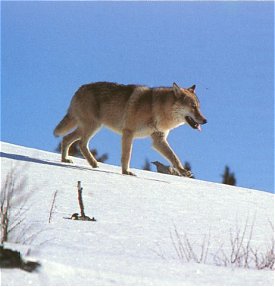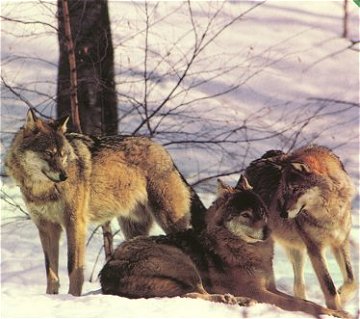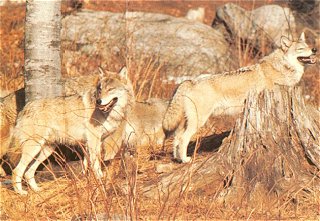European Wolves

European wolves, as most all others, live and hunt in packs, which are extended families of an alpha, his mate, and thier offsprings. They usually stay within a home range, but may wander far outside thier territory to hunt. European wolves hunt and kill game up to ten times heacier than their own weight. European wolves prey on wild reindeer, elk, and red deer, these are their favorite prey. These wolves will also eat must smaller animals such as mice and frogs. Because of the declind in wild game, european wolves have started preying on domestic horses, cattle, and sometimes dogs (which is unfortunate). The only reason that these european wolves eat domestic animals is because humans will hunt for sport and leave nothing for the wolves to hunt. Starving wolves will even eat potatoes, fruits, buds, and lichen.
The alpha male and female mate between January and March, which is much different than a red wolf. The european cubs are born seven weeks later in a den that the parents have dug for them, among bushes or rocks. The male brings food back to the den, either by carrying it whole or by swallowing and than regurgitating it for the others to eat. As the european cubs grow, the mother and other members of the pack help to feed them.

European wolves have mamaged to survive only in the most remote, mountainous, or densely forested regions. Areas in which these wolves can live without coming into conflict with humans are decreasing rapadly. There is not much effort to have international european wolf conservations, so all the efforts to preserve the european wolf, are held locally.
Because of the increasing shortage of natural prey in Italy, european wolves have been forced to give up their pack-hunting habits, and scavenge for food around villages and farmhouses. About two hundred and fifty wolves live in remote mountainous areas in Italy, and are officially protected. Many rural villages have open dumps where the local slaughterhouse disposes of its waste. May wolves will feed there alongside feral or stray dogs. These dogs and wolves will occasionally mate, and their offspring are often impossible to distinguish from ordinary dogs.
The wolf-dog's deceptibe apearance means that it is quite dangerous. Wolf-dogs may wander freely through populated areas, unrecognized as wolves. They are usually more wild than their feral parents. Wolf-dogs can be extremely ferocious,andare often infected with rabies.
In Norway, european wolves are protected to the extent that they are illegal to kill by anyone other than farmers protecting their livestock.

"Grupo Lobo" was founded in Spain and Portugal in 1985 in attempt to protect the wolves in the mountains on the Spain/Portugal border. There is an extremely small number of wolves in Sweden, ragardless of protective legislation.
The "wolf-plague" in Scotland resulted in the extermination of the animal there. The last British wolf died in 1743. The European wolves survived in Ireland until about 1773. Similar waves of wolf persecution on the European continent has driven the few survivors into remote areas far away from human settlement. The wolves survival in Europe obviosly requires more than simple legislations. These wolves are rather shy and intelligen, yet they are still viewed as a ruthless predator by the mainstream.
